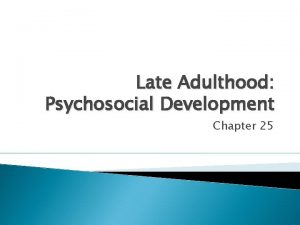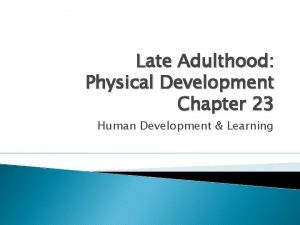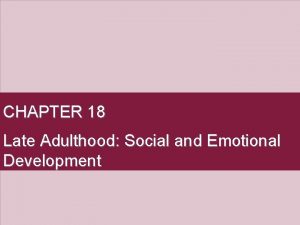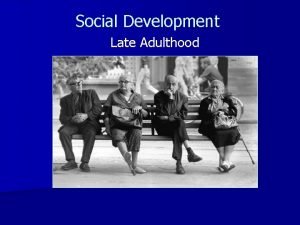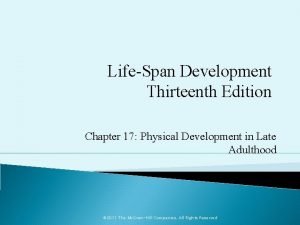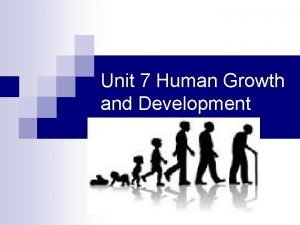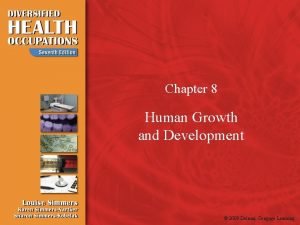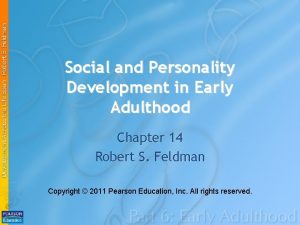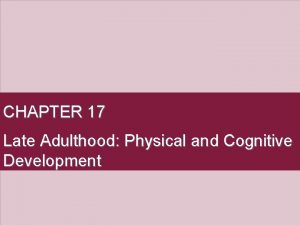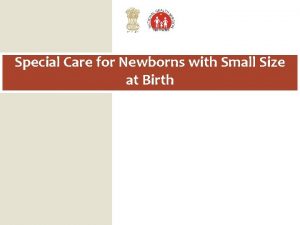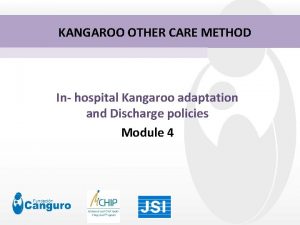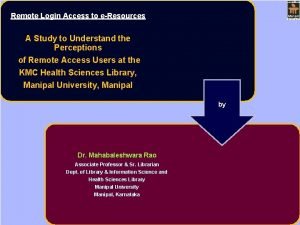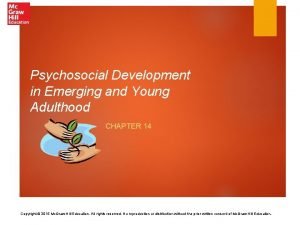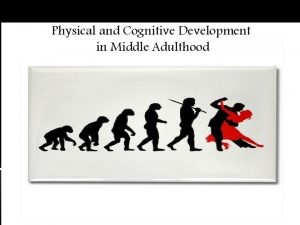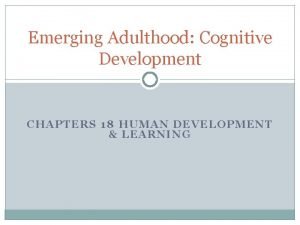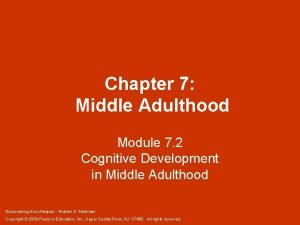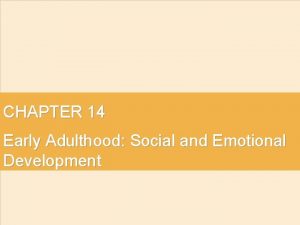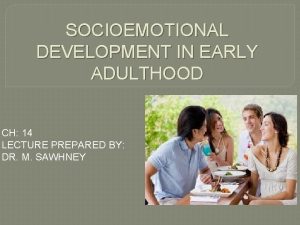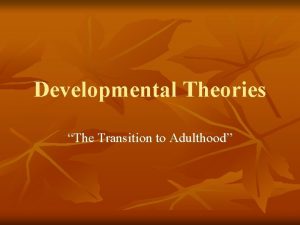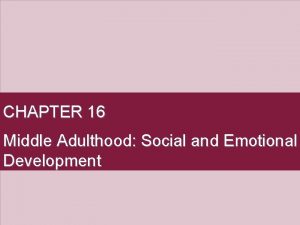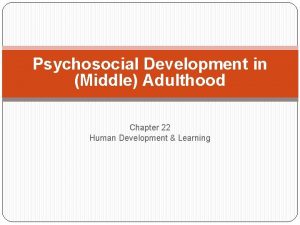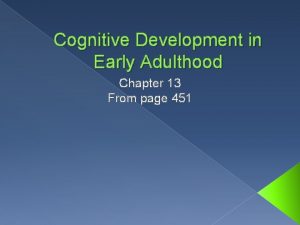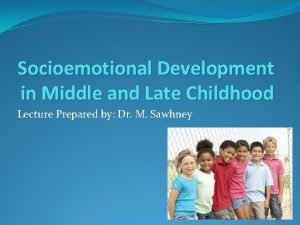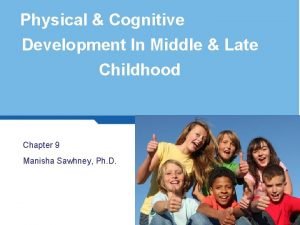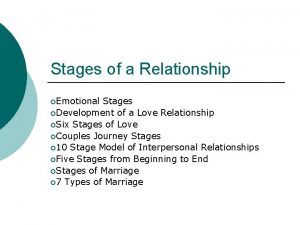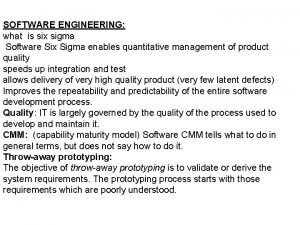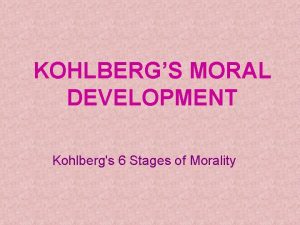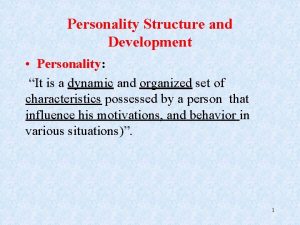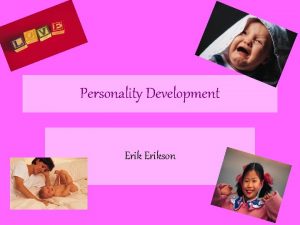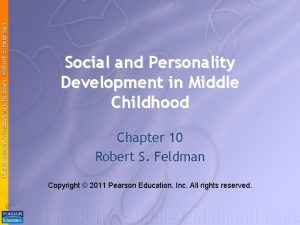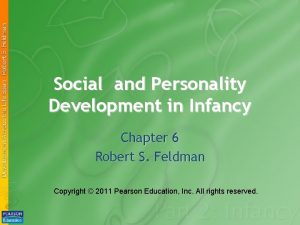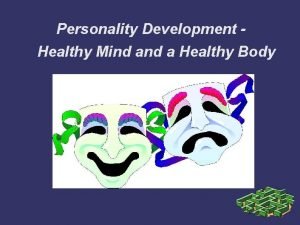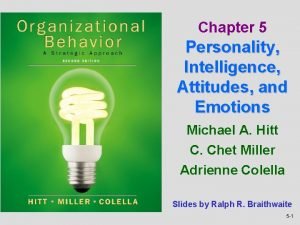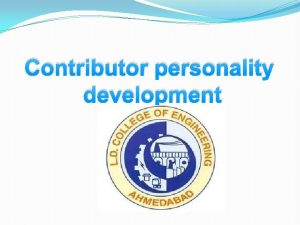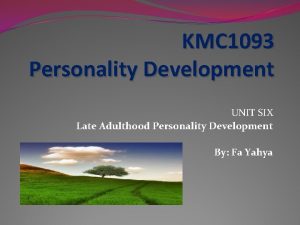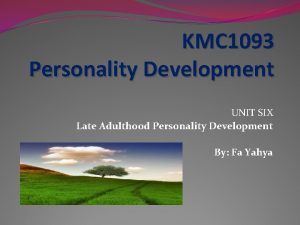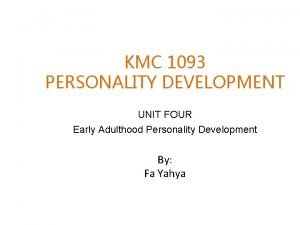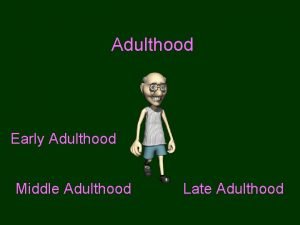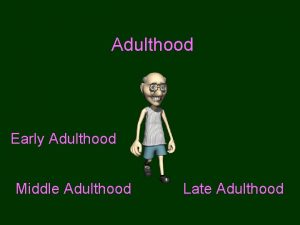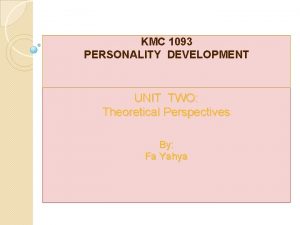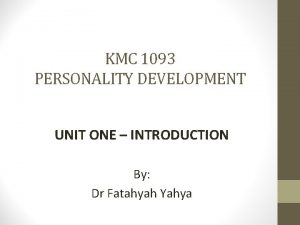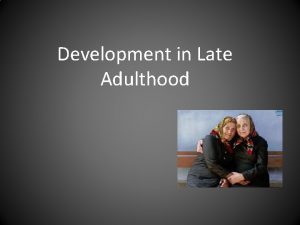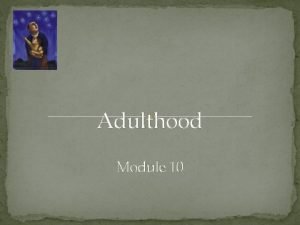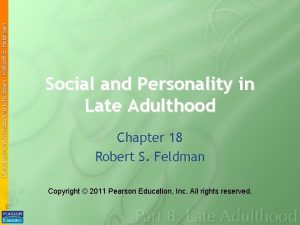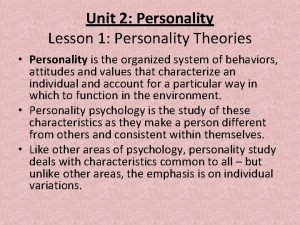KMC 1093 Personality Development UNIT SIX Late Adulthood






















































- Slides: 54

KMC 1093 Personality Development UNIT SIX Late Adulthood Personality Development By: Fa Yahya

Table Of Content � Introduction � The self and society � Older adult in society � Policy issues in an aging society � Continuity and change in PD � Discontinuity in PD: What theories says? : � Erikson � Robert Peck � Daniel Levinson � Bernice Neugarten � Life Review and Wisdom � Age stratification approach � Successful aging secret � Disengagement theory � Activity Theory � Continuity Theory � Spouse � Social Support � Grandparenting � Retirement � Atchley’s stage � Stress of retirement � Sucessful retirement � Other issues � Life satisfaction of late adulthood

Learning Unit Objectives �Discuss about older adult in society and policy issues in an aging society �Discuss about continuity and change in PD as well as discontinuity in PD �Discuss about Life Review and Wisdom �Discuss about Age stratification approach �Discuss about theories of Successful aging secret �discuss about Social Support and Grandparenting �Discuss about Retirement and issues related to it. �Discuss about Life satisfaction of late adulthood

Introduction �Late adulthood is the term coined by developmental psychologist describing the period in an individual’s life beginning at ages sixty or seventy and ending at death. �Late adulthood as a period of considerable diversity in which people change. �Growth in some areas, decline in others.

The Self and Society 1 - Self esteem �increased in the 20 s, leveled off in the 30 s and 40 s, rose considerably in 50 s and 60 s, and then dropped significantly in 70 s and 80 s. �Male higher than female (most of adult years) �During 70 s and 80 s, female and male converged (join together). �Why the level of self esteem declined? �deteriorating physical health and negative societal attitudes toward older adults. �being widowed, institutionalized or physically impaired, having low religious commitment, and decline in health conditions

2 - Possible Selves �Refer to what individuals might become, what they would like to become and what they are afraid of becoming.

3 - Self Acceptance �Based on study, self acceptance of individuals at different points in adults development depended on whether they were describing their past, present, future or ideal selves. �There was little difference in acceptance of various selves because of decreased acceptance of ideal and future selves and increased acceptance of past selves.

4 - Self Control �the ability to control one's emotions, behaviour and desires. In psychology, it is sometimes called self regulation. �Based on research (60 -90 years), self control was lowest in physical domain and in another study, perceived self control declined in cognitive functioning.

Older Adults in Society �Stereotyping Older Adults : social participation by older adults is often discouraged by ageism. - Ageism - prejudice against others because of their age, especially prejudice against older adults. - They are perceived as incapable of thinking clearly, learning new things, enjoying sex, contributing to the community and holding responsible jobs. - Research indicates that the most frequent form is disrespect for older adults, followed by assumptions about ailments or sickness caused by age.

Policy Issues in an Aging Society � 1 - Status of Economy � 2 - Health Care � 3 - Eldercare �physical and emotional caretaking of older members of the family, whether that care is day to day physical assistance or responsibility for arranging and overseeing such care. � 4 - Generational Inequity � the view that our aging society is being unfair to its younger members because older adults pile up advantages receiving inequitably large allocations of resources. �Issues to be concerned: Income, living arrangements and technology

How is old age divided? �Some researchers divide aging people into three groups: �Young old are healthy and active �(65 -74 years old) �Old old have some health problems and difficulties �(75 -84 years old) �Oldest old are frail and need care �(85 and older)

Continuity and Change in Personality �Fundamental continuity to personality � Despite this general stability of basic personality traits, there is still the possibility of change over time. �Profound social environmental changes throughout adulthood may produce fluctuations and changes in personality �Some discontinuities in development � What is important to a person at age 80 is not necessarily the same as what was important at age 40.

Discontinuities of Development: What Do Theorists Say? �Erikson �Robert Peck �Daniel Levinson �Bernice Neugarten �Changes in personality occur as a result of new challenges in later adulthood.

1. Erikson EGO-INTEGRITY-VERSUS-DESPAIR Process of looking back over one's life, evaluating it, and coming to terms with it � Stage begins when the individual experiences a sense of mortality. • This may be in response to retirement, the death of a spouse or close friends, or may simply result from changing social roles. • No matter what the cause, this sense of mortality precipitates the final life crisis. q Integrity q Comes when people feel they have realized and fulfilled the possibilities that have come their way q Despair q Occurs when people feel dissatisfied with their life, and experience gloom, unhappiness, depression, anger, or the feeling that they have failed

2. Robert Peck Personality development in elderly people is occupied by three major developmental tasks or challenges: �Redefinition of self VS preoccupation-with-work-role �Body-transcendence VS body-preoccupation �Ego-transcendence VS ego-preoccupation

1. Redefinition of self VS preoccupation-with-work-role � which means that those in old age must redefine themselves in ways that do not relate to their work-roles or occupations � People must adjust their values to place less emphasis on themselves as workers or professionals and more on attributes that don’t involve work, such as being a grandparent or a gardener.

2. Body-transcendence VS body-preoccupation � a period in which people must learn to cope with and move beyond changes in physical capabilities as a result of aging. � People must learn to cope with and move beyond those physical changes (transcendence).

3. Ego-transcendence VS ego-preoccupation � in which elderly people must come to grips with their coming death. � Elderly people must understand that although death is inevitable, and probably not too far off, they have made contributions to society. � If people in late adulthood see these contributions, they will experience ego transcendence. � If not, they may become preoccupied with the question of whether their lives had value and worth to society.

3. Daniel Levinson �According to Daniel Levinson, people enter late adulthood after passing through a transition stage that typically occurs about age 60 to 65. �View themselves as being “old” : People struggle with being "old", and often must face illness and death of one's friends and loved ones. �Recognize stereotypes and loss of power, authority and respect �Serve as resources to younger individuals and be in a position to give advice. �Discover new freedom to do things for simple sake of enjoyment and pleasure

4. Bernice Neugarten q. Four different personality types in people in their 70 s: Ø Disintegrated and disorganized Ø Passive-dependent personalities Ø Defended personalities Ø Integrated personalities

�Disintegrated & disorganized • • • Unable to accept aging Experience despair as they age Often end up in nursing homes, or are hospitalized �Passive-dependent personalities • � • Lead lives filled with fear (Illness, Future, Inability to cope) May seek out hope, even when not needed �Defended personalities • • • Seek to ward off aging May try to act young Exercise vigorously Youthful activities Unrealistic expectations may lead to disappointment �Integrated personalities • • • Most successful Cope comfortably with aging Accept becoming older & maintain self dignity

ü ü ü Erikson, Peck, Levinson & Neugarten all suggest that a major characteristic of personality development in old age is looking backward, called a LIFE REVIEW, where people examine and evaluate their lives, experiences, evaluating, interpreting and often reinterpreting them. Very important in this stage It can includes : � socio-cultural dimensions : culture, ethnicity and gender � Interpersonal relationship dimension : sharing and intimacy with family members or friends � Personal dimension: involve the creation and discovery of meaning and logic.

Life Review & Reminiscence (nostalgia): The Common Theme of Personality Development According to Robert Butler, the life review is triggered by the increasing awareness that one will die. � There are benefits to a life review. � � a better understanding of one's life resolution of lingering problems a sense of sharing and mutuality with others like them may improve memory

� A life review is not always positive. People may become obsessed with the past. � This may cause psychological dysfunction � � Overall, a life review and reminiscence can play an important role in the ongoing lives of the elderly Continuity between past & present � Increases awareness of the contemporary world � New insights �

§ Another aspect of life review involves identifying and reflecting the positive and negative aspects of life. § The purpose is to create and understand the wisdoms. § Based on research (40 -85 years), regret involve 4 major themes: 1. mistakes and bad decision 2. hard times 3. social relationship 4. missed educational opportunities

Wisdom �Wisdom—expert knowledge in the practical aspects of life �Reflects accumulation of knowledge, experience, and contemplation �Wisdom is not the same as intelligence: � While knowledge that is derived from intelligence is related to the here-and-now, wisdom is a more timeless quality. � While intelligence may permit a person to think logically and systematically, wisdom provides an understanding of human behavior.

Age Stratification Approaches to Late Adulthood �Suggest that economic resources, power, and privilege are distributed unequally at different stages of the life course. �Power declines among elderly in industrialized nations lead to more distance between this group and young adults �Power and prestige for elderly have eroded in industrialized societies �Rapidly changing technology causes older adults to be seen as lacking important skills �Older adults are seen as non-productive members of society and in some cases simply irrelevant

Successful Aging Secrets Three major approaches �Disengagement theory �Activity theory �Continuity theory

1. Disengagement Theory: Gradual Retreat �Late adulthood involves gradual withdrawal from world on physical, psychological, and social levels Ø On a physical level, elderly people have lower energy levels and tend to slow down progressively. Ø Psychologically, they begin to withdraw from others, showing less interest in the world around them and spending more time looking inward. Ø On a social level, they engage in less interaction with others, in terms of both day-to-day, face-to-face encounters and participation in society as a whole. Older adults also become less involved and invested in the lives of others.

Ø Withdrawal is a mutual process and not necessarily negative since outcomes of disengagement are largely positive: • According to this view, the gradual withdrawal of people in late adulthood permits them to become more reflective about their own lives and less constrained by social roles � People can become more discerning in their social relationships, focusing on those who best meet their needs. Disengagement can be liberating. � Decreased emotional investment in others can be viewed as beneficial. By investing less emotional energy in their social relationships with others, people in late adulthood are better able to adjust to the increasing frequency of serious illness and death among their peers.

2. Activity Theory: Continued Involvement �Activity theory suggests that successful aging occurs when people maintain the interests and activities they pursued during middle age and resist any decrease in the amount and type of social interaction they have with others. � Specific nature and quality of the activities in which people engage are likely to be more critical than the mere quantity or frequency of their activities. � Some people view the ability to moderate their pace as one of the bounties of late adulthood. For them, a relatively inactive, and perhaps even solitary, existence is welcomed. � Happiness and satisfaction from high level of involvement � Adaptation to inevitable changes � Continuing/replacing previous activities

3. Continuity Theory: A Compromise Position � People need to maintain their desired level of involvement in society to maximize their sense of well-being and self-esteem. � Highly active and social people will be happiest if they largely remain so. Those more retiring individuals, who enjoy solitude and solitary interests, will be happiest if they are free to pursue that level of sociability. � Old age can influence their happiness and satisfaction. Those who view late adulthood in terms of positive are apt to perceive themselves in a more positive light than those who view old age in a more pessimistic and unfavorable way. � Regardless of activity level, most older adults experience positive emotions as frequently as younger individuals � Good physical and mental health is important in determining overall sense of wellbeing. � Adults engage in the same sorts of behaviors they always have: � MEN: engage in work, leisure activities, role of father, husband � WOMEN: engage in roles of mother, wife, worker, volunteer, and leisure activities

Caring for an Aging Spouse �Wide variety of reactions � • • • Positive Negative Feel great frustration and even despair View caring for an ailing and dying spouse in more positive light, regarding it in part as a final opportunity to demonstrate love and devotion Feel quite satisfied as a result of fulfilling what they see as their responsibility to their spouse Find initial experience emotionally distressful but distress declines as they successfully adapt to stress of care giving In most cases, caregiver is wife. • Just under three-quarters of people who provide care to a spouse are women. • Reasons: • demographic factor: Men tend to die earlier than women, and consequently they contract the diseases leading to death earlier than women. • society’s traditional gender roles, which view women as “natural” caregivers. As a consequence, health care providers may be more likely to suggest that a wife care for her husband than that a husband care for his wife.

Death of Spouse �Few events are more painful than death of spouse �No longer part of a couple �Must deal with profound grief �No one to share life with and social life often changes �Economic changes often occur

Social Support: The Significance Of Others � Friends provide SOCIAL SUPPORT: assistance and comfort supplied by another person or a network of caring, interested people. � Social support is important for successful aging. � Provides an ear. � Can sympathize when they have been through the same crises. � Can help furnish material support such as solve problems, give a ride, or fix broken things.

Why do friends matter? �Because late adulthood may bring with it a gradual loss of control in other areas, such as in one’s health, the ability to maintain friendships may take on more importance than in other stages of life. �Friendships in late adulthood: �Allow older adults more control about whom to include in a friendship �May be more flexible �Relate to increasing likelihood, over time, that one will be without marital partner.

Family Relationships �Connections is important �Siblings, children, grandchildren, and greatgrandchildren provide an important source of comfort to adults in last years of their lives �Siblings are important because of shared life �Children often most important

Grandparents �Not all grandparents are equally involved with their grandchildren �Gender differences in behaviors and reactions of grandparents and grandchildren �Ethnic differences in grandparenting

• Grandmothers tend to be more involved with their grandchildren than grandfathers; similarly, there are gender differences in the feelings grandchildren have toward their grandparents. • Most young adult grandchildren feel closer to their grandmothers than to their grandfathers. • Most express a preference for their maternal grandmothers over their paternal grandmothers.

Retirement � Definition: � Retirement is the status of a worker who has stopped working. � This usually happens upon: � reaching a determined age, � physical conditions don't allow the person to work any more (by illness or accident), � personal choice (the presence of an adequate pension, desire to travel, study, or spend more time with family ) � Burnout • When to retire is a major decision faced by the majority of people in late adulthood. • Typical retirement age is moving downward to age 60. • Social Security and pensions allow people to retire earlier. • A disincentive is built into Social Security by having workers taxed at higher rates on both Social Security and earnings. • Many people continue to work full- or part-time for some part of late adulthood.

• Mandatory retirement is illegal (since the 1970 s) with the exception of certain public safety jobs such as police, firefighters, prison guards, and pilots. • The retirement decision is based on a number of factors. • Workers may be burned out after working all their lives. • Jobs can be frustrating and tension-filled. • Health may decline. • Incentives are offered by their company to retire early. • Desire to travel and see more of family.

Atchley’s Stages In The Process Of Retirement PHASE 1 Pre- Retirement PHASE 2 Retirement PHASE 3 Disenchantment PHASE 4 Reorientation PHASE 5 Retirement Routine PHASE 6 Termination of Retirement � These phases do not apply to everyone, because retirement is experienced on an individual basis; however, these phases do provide a guide for thinking about what some individuals may encounter when they transition into the retirement stage of life.

�Phase 1: Preretirement �The phase prior to the actual retirement experience usually involves both disengagement from the workplace and planning for what retirement will entail.

�Phase 2: Retirement � When a person "retires" and therefore, no longer participates in paid employment, they frequently take one of three possible paths: � The "honeymoon" in which former workers engage in a variety of activities, such as travel, that were previously hindered by full-time work. � The "immediate retirement routine" path is adopted by those who already had a full and active schedule in addition to their employment. These individuals easily establish comfortable, yet busy schedules soon after retirement. � The "rest and relaxation" path is described as a period of very low activity as compared to the "honeymoon" path. Persons who have had very busy careers with limited time to themselves frequently choose to do very little in their early retirement years. Frequently, however, activity levels do increase after a few years of rest and relaxation.

�Phase 3: Disenchantment �may occur when retirees conclude that retirement is not all they thought it would be. �Phase 4: Reorientation � is the stage where retirees reconsider their options and become engaged in new, more fulfilling activities.

�Phase 5: Retirement Routine �occurs when retirees come to grips with the realities of retirement and feel fulfilled in this new phase of life. �Phase 6: Termination of Retirement �the retiree either goes back to work or health deteriorates so badly that the person can no longer function independently.

Stress of Retirement �Stress of retirement or old age may change relationship � 2 percent of divorces in the U. S. involve women over 60 �Husband may be abusive or alcoholic �Husband may find a younger woman �Divorce is harder on women than men � 5 percent of the elderly never married and late adulthood brings fewer changes to their lives

Gerontologists suggest several factors related to a successful retirement � � Plan ahead financially. Explore your interests before you retire. Plan to volunteer your time. Refashioned Relationships �More time together �More sharing in household chores �Role reversals �Health changes

Other Issues in Late Adulthood As we age we become more socially selective Adults tend to limit their contacts to individuals with whom they have developed pleasurable, rewarding, relationships Rapidly changing technology causes older adults to be seen as lacking important skills Older adults are seen as non-productive members of society and in some cases simply irrelevant Living in Nursing Homes Economics of Late Adulthood: 1. 2. 3. 4. 5. 6. I. II. People who were well-off in young adulthood remain so in late adulthood Those who were poor remain poor in late adulthood

7. Financial Vulnerability in Older Adulthood -Reliance on a fixed income for support *Pensions, and savings *Rising cost of health care - The Cost of Staying Well � Elderly face rising health costs � Average older person spends 20 percent of his or her income on health care costs � Nursing homes can cost RM 20, 000 to RM 40, 000 a year 8. Elder Abuse Physical or psychological mistreatment or neglect of elderly individuals � May affect as many as 2 million people above the age of 60 each year � Is most frequently committed by family member

Culture Shapes the Way We Treat People in Adulthood �Cultures that revere old age have several things in common. �They are homogeneous in socioeconomic terms and the elderly control the finances. �Older adults in these cultures continue to engage in activities that are valued by society. �These cultures tend to be organized around extended families.

Life Satisfaction of Late Adulthood � Older adults with adequate income are more likely to be satisfied with their lives than older adults with less adequate income � Healthy older adults are more likely than unhealthy older adults to have high life satisfaction � An active life-style is associated with high life satisfaction � Older adults with an extended social network of friends and family are more likely to be satisfied with their lives � A close attachment to one or more individuals is associated with high life satisfaction

�Late adulthood is a time of relinquishing some roles and adopting new ones. • When to retire is a major decision faced by the majority of people in late adulthood. • Late adulthood should prepared themselves to face the issues and difficulties at this stage.

 Late adulthood psychosocial development
Late adulthood psychosocial development Ros
Ros Intellectual development in later adulthood
Intellectual development in later adulthood Emotional development in late adulthood
Emotional development in late adulthood Socioemotional development in late adulthood
Socioemotional development in late adulthood Socioemotional selectivity theory
Socioemotional selectivity theory Physical development in late adulthood
Physical development in late adulthood Fraction definition
Fraction definition Site:slidetodoc.com
Site:slidetodoc.com Emotional development in late adulthood
Emotional development in late adulthood Www.chemsheets.co.uk
Www.chemsheets.co.uk P 1093
P 1093 Personality development in early adulthood
Personality development in early adulthood Physical changes in late adulthood
Physical changes in late adulthood Kmc position image
Kmc position image Kmc position image
Kmc position image Kangaroo mother care components
Kangaroo mother care components Kmc chart
Kmc chart Kmc agro
Kmc agro Kmc library proxy
Kmc library proxy Kmc register
Kmc register Emerging adulthood psychosocial development
Emerging adulthood psychosocial development Middle adulthood cognitive development
Middle adulthood cognitive development Cognitive development early adulthood
Cognitive development early adulthood Filial maturity
Filial maturity Adulthood social development
Adulthood social development Social development in late childhood
Social development in late childhood Emotional changes in middle adulthood
Emotional changes in middle adulthood Emerging adulthood cognitive development
Emerging adulthood cognitive development Early adulthood developmental stage
Early adulthood developmental stage Cognitive development in middle adulthood
Cognitive development in middle adulthood Emotional development of early adulthood
Emotional development of early adulthood Cognitive development in early adulthood
Cognitive development in early adulthood Socioemotional development in early adulthood
Socioemotional development in early adulthood Which way now
Which way now Middle adulthood social changes
Middle adulthood social changes Permaparenting
Permaparenting Labouvie-vief pragmatic thought
Labouvie-vief pragmatic thought Late childhood social development
Late childhood social development Late childhood
Late childhood Middle and late childhood physical development
Middle and late childhood physical development Classify each polygon
Classify each polygon Unit 10, unit 10 review tests, unit 10 general test
Unit 10, unit 10 review tests, unit 10 general test Relationship growth stages
Relationship growth stages Six sigma software development
Six sigma software development What are the six stages of moral development?
What are the six stages of moral development? Examples of passive-aggressive
Examples of passive-aggressive Erikson personality development
Erikson personality development Physical defects in personality development
Physical defects in personality development Personality development in infants
Personality development in infants Damon's stages of friendship
Damon's stages of friendship Personality development in infancy
Personality development in infancy Summary of personality development
Summary of personality development Determinants of personality development
Determinants of personality development Non contributor example
Non contributor example
